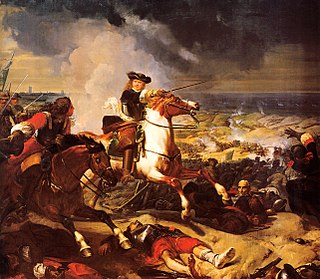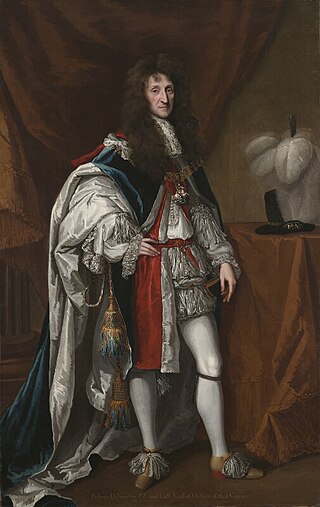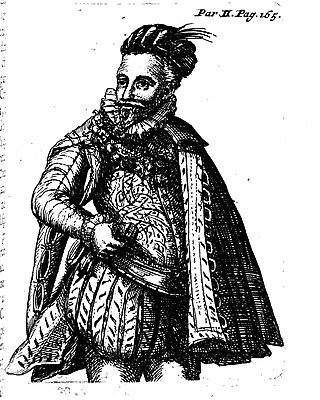Related Research Articles
The Sealed Knot was a secret Royalist association which plotted for the Restoration of the Monarchy during the English Interregnum. The group was commissioned by King Charles II between November 1653 and February 1654 from his exile in Paris for the purpose of coordinating underground Royalist activity in England and preparing for a general uprising against the Protectorate.

The Battle of the Dunes, also known as the Battle of Dunkirk, took place on 14 June 1658, near the strategic port of Dunkirk in what was then the Spanish Netherlands. Part of the Franco-Spanish War and concurrent Anglo-Spanish War, a French army under Turenne, supported by troops from the Commonwealth of England, had besieged Dunkirk. Led by John of Austria the Younger and Louis, Grand Condé, a Spanish force supported by English Royalists and French Fronde rebels attempted to raise the siege but suffered a severe defeat.

Sir William Davenant, also spelled D'Avenant, was an English poet and playwright. Along with Thomas Killigrew, Davenant was one of the rare figures in English Renaissance theatre whose career spanned both the Caroline and Restoration eras and who was active both before and after the English Civil War and during the Interregnum.
This article contains information about the literary events and publications of 1656.

Edward Montagu, 1st Earl of Sandwich, 27 July 1625 to 28 May 1672, was an English military officer, politician and diplomat from Barnwell, Northamptonshire. During the First English Civil War, he served with the Parliamentarian army, and was an MP at various times between 1645 and 1660. Under The Protectorate, he was also a member of the English Council of State and General at sea.

Lieutenant-General Henry Wilmot, 1st Earl of Rochester, known as The Lord Wilmot between 1643 and 1644 and as The Viscount Wilmot between 1644 and 1652, was an English Cavalier who fought for the Royalist cause during the Wars of the Three Kingdoms.
Lord Wentworth's Regiment was a regiment of infantry raised during the exile of King Charles II during the Interregnum to serve in the Royalist Army in Exile. Formed as the Royal Regiment of Guards in 1656 at Bruges under the command of the Earl of Rochester. It was made up of men who remained loyal to the King and had followed him into exile. When Rochester died in February 1658 command passed to Thomas Wentworth, 5th Baron Wentworth. The regiment served as part of the Spanish Army during the Franco-Spanish War and the concurrent Anglo-Spanish War in the Spanish Netherlands and saw action at the Battle of the Dunes (1658) under the command of Wentworth, before accompanying the King back to England to reclaim the throne at the Restoration in 1660. In 1665, the regiment was amalgamated with John Russell's Regiment of Guards to form the 1st Regiment of Foot Guards.

Sir William Lockhart of Lee (1621–1675), was a Scottish soldier and diplomat who fought for the Covenanters during the 1638 to 1651 Wars of the Three Kingdoms. Following Royalist defeat in the 1642 to 1647 First English Civil War, Lockhart took part in negotiations between Charles I and Scottish Engagers, who agreed to restore him to the English throne.

Thomas Belasyse, 1st Earl Fauconberg PC was an English peer. He supported the Parliamentary cause in the English Civil War, becoming close to Oliver Cromwell and marrying Cromwell's third daughter, Mary. After the Restoration of the monarchy he became a member of the Privy Council to Charles II and was elevated to an earldom by William III.

Aubrey de Vere, 20th Earl of Oxford, KG, PC was an English peer and military officer who fought on the Royalist side during the English Civil War.
The Treaty of Paris signed in March 1657 allied the English Protectorate of Oliver Cromwell with King Louis XIV of France against King Philip IV of Spain, merging the Anglo-Spanish War (1654–1660) with the larger Franco-Spanish War (1635–1659). The treaty confirmed the growing rapprochement between France and the English Republican regime.
Events from the year 1650 in England, second year of the Third English Civil War.
Events from the year 1654 in England.
Events from the year 1657 in England.
Events from the year 1658 in England.

Thomas Wharton (1614–1673) was an English physician and anatomist best known for his descriptions of the submandibular duct and Wharton's jelly of the umbilical cord.
Henry Jones of Asthall Manor, Oxfordshire was an officer in the New Model Army during the Interregnum. He transferred to the new small Royalist army of Charles II, serving as a Life Guard until he was dismissed after becoming a Roman Catholic. With King Charles's blessing he raised an English regiment of horse (cavalry) known as English Regiment of Light Horse in France for the French Army of Louis XIV. He was killed in action at the siege of Maastricht.
The Treaty of Brussels was an agreement between representatives of Philip IV of Spain and Charles II, the leader of the exiled royalists of England, Ireland, and Scotland. It was signed in Brussels, in the Spanish Netherlands, on 2 April 1656. Marquess of Ormonde and the Earl of Rochester signed on behalf of Charles. Alonso de Cárdenas, a former Spanish ambassador to London, signed on behalf of Philip.

Alonso de Cárdenas was the Spanish ambassador to London between 1638 and 1655, during the English Commonwealth.

The Royalist Army in Exile was the army formed by those loyal to Charles II from 1656 to 1660 during his exile from the throne. They were a mixture of Royalist troops from his three Kingdoms including men from England and Scotland, with the bulk being Catholics from Ireland, many of whom had previously served in the Irish Confederate armies.
References
- 1 2 3 4 "1656, British Civil Wars". Archived from the original on 12 October 2007. Retrieved 2007-09-20.
- 1 2 Williams, Hywel (2005). Cassell's Chronology of World History . London: Weidenfeld & Nicolson. p. 267. ISBN 0-304-35730-8.
- ↑ "The King's Own Regiment of Guards". BCW Project. Retrieved 2023-05-30.
- ↑ "Musaeum Tradescantianum". The Tradescant Collection. Oxford: Ashmolean Museum. 2002-01-15. Retrieved 2011-04-10.